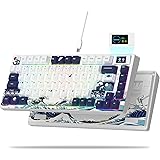The Unfolding Saga of Gaming Control: An Expert Look at Video Game Controller Evolution
As explored in the video above, the evolution of video game controllers represents a compelling journey of design, engineering, and human-computer interaction. From the rudimentary digital sticks of the late 1970s to today’s sophisticated, ergonomic input devices, each generation has built upon the last, refining gameplay, expanding possibilities, and fundamentally shaping the gaming landscape. This deep dive into the history of game controllers reveals not just technological advancements, but also the shifting philosophies behind how players interact with their virtual worlds.
Understanding this lineage is crucial for appreciating the intricate design choices that define modern gaming. The path was anything but linear, featuring brilliant innovations alongside ambitious failures. We trace the key milestones and design decisions that collectively forged the controllers we know and love today, focusing on the critical contributions from industry giants like Atari, Nintendo, Sega, Sony, and Microsoft.
Pioneering Input Devices: The Dawn of Digital Control
The genesis of the modern game controller can be traced back to the late 1970s, a period where home gaming was still in its infancy. In 1977, the **Atari CX10 joystick** emerged as the primary controller for the iconic Atari 2600. This nine-pin digital controller, featuring a simple joystick and a single action button, was a foundational piece of gaming hardware.
Despite its stark simplicity, the Atari joystick established critical conventions that persist today. Its four-directional input and singular action button defined the player’s basic interaction with early titles. While not the very first controller, its digital nature marked a significant departure from earlier analog designs, setting a new standard for precision and responsiveness in gameplay. Shortly after, the 1978 Magnavox Odyssey controller offered a modest upgrade with an eight-directional joystick, expanding movement fidelity.
The Experimental Era: Buttons, Keypads, and Ergonomic Challenges
The early 1980s saw a burst of experimentation in game controller design, driven by the nascent desire for more complex gameplay. The 1979 **Intellivision controller** exemplifies this ambition, featuring a 12-button numeric keypad, side-mounted action buttons, and a 16-direction control disc. This innovative but cumbersome design highlighted the industry’s struggle to balance expanded functionality with user comfort.
Similarly, the 1980 ColecoVision controller and 1982 Atari 5200 controller continued this trend, integrating numeric keypads and more buttons into their designs. While acknowledging the need for increased input, these controllers were often criticized for their awkward ergonomics and unintuitive layouts. This period underscored a critical lesson: more buttons do not automatically equate to better gameplay or user experience, especially if they compromise comfort and ease of use. The industry was grappling with how to make games bigger and better, but often overlooked the user interface.
The D-Pad Revolution: Simplicity Meets Precision
The infamous video game crash of 1983 prompted a re-evaluation of game design, including controller philosophy. Nintendo, amidst the industry’s turmoil, seized an opportunity by simplifying the controller while enhancing its precision. The 1983 **Nintendo controller**, accompanying the NES and Famicom, introduced the revolutionary D-pad (directional pad).
Replacing the bulky joystick, the cross-shaped D-pad offered intuitive four-way (and effectively eight-way) directional input, paired with A, B, Select, and Start buttons. This design provided expanded functionality without the cognitive load of keypads, making games more accessible and enjoyable. The D-pad’s influence was immediate and profound, quickly becoming a standard across the industry, as seen with Sega’s Master System controller in 1986 and its slightly refined square D-pad.
Expanding Functionality: Sega Genesis and Super Nintendo Set New Benchmarks
As games grew more sophisticated, so too did the demand for additional inputs. The 1988 **Sega Genesis controller** was a pivotal moment, increasing the face button count to three (A, B, C) and introducing subtle ergonomic curves. These curves hinted at the importance of hand comfort during extended play sessions. Its later six-button variant further solidified the need for multiple, easily accessible action buttons, particularly for fighting games.
Nintendo responded in 1990 with the **Super Nintendo Entertainment System (SNES) controller**, a design considered by many to be one of the most influential ever created. It refined the Genesis’s ergonomic curves and significantly expanded inputs, featuring four face buttons (A, B, X, Y) in a diamond layout, and crucially, two shoulder buttons (L and R). These shoulder buttons were a game-changer, enabling new gameplay mechanics like camera rotation, weapon switching, or additional character actions without repositioning the thumbs. The SNES controller’s layout laid much of the groundwork for modern gamepad design, a testament to its forward-thinking approach.
Embracing 3D and Analog Input: The N64 and PlayStation Era
The mid-1990s marked a dramatic shift in gaming with the advent of 3D graphics, which necessitated a new paradigm for player movement and camera control. Traditional D-pads, while excellent for 2D, proved insufficient for nuanced 3D navigation. This led to the introduction of analog input, allowing for variable movement speed and precise spatial control.
The 1996 **Nintendo 64 controller** showcased a radical, M-shaped design, prominently featuring a central analog stick. This innovation allowed for fluid 3D movement, complemented by a D-pad, four C-buttons for camera control, and a Z-trigger. While innovative, its three-pronged design often required players to shift hand positions. That same year, the **Sega Saturn 3D controller** offered an alternative, featuring a similar analog stick layout on one grip, hinting at future dual-stick designs.
However, it was Sony’s 1997 **PlayStation DualShock controller** that truly codified the modern dual-analog stick layout. Building on the original PlayStation controller’s design (which itself evolved from the SNES with added grips and triggers), the DualShock integrated two analog sticks symmetrically positioned below the D-pad and face buttons. This symmetrical dual-stick configuration became the industry standard for 3D gaming, particularly for first-person shooters and adventure games, offering unparalleled control over both movement and camera. The DualShock also famously introduced haptic feedback, or “rumble,” adding a new layer of immersion to gameplay.
Wireless Freedom and Ergonomic Refinement
With the core layout established, the next major frontier for game controllers was wireless connectivity and continuous ergonomic improvement. Nintendo once again innovated in 2002 with the **WaveBird RF controller** for the GameCube. This was the first truly effective and widely adopted wireless controller, using robust RF frequencies to eliminate latency and line-of-sight issues, setting a new bar for wireless gaming freedom.
Microsoft’s journey in the early 2000s saw the bulky original Xbox controller, affectionately dubbed “the Duke,” give way to the more refined **Controller S** in 2002. This smaller, more ergonomic design became the blueprint for future Xbox controllers. The **Xbox 360 controller**, released in 2005, further honed this ergonomic excellence, becoming a benchmark for comfort and a popular choice for PC gaming due to its seamless plug-and-play USB functionality. While the transcript mentions Bluetooth, it’s worth noting the Xbox 360’s wireless variant utilized a proprietary RF protocol, not Bluetooth, for its connectivity, contrasting with Sony’s adoption of Bluetooth for the PlayStation 3’s Sixaxis controller.
Motion Sensing and Hybrid Designs: Nintendo’s Continued Innovation
Nintendo consistently pushed boundaries beyond traditional button-and-stick layouts. The 2006 **Wiimote**, accompanying the Wii, introduced widespread motion control to a mainstream audience. Combining an accelerometer with an optical sensor, it allowed for intuitive gesture-based gameplay and precise pointing. While sometimes overused by third-party developers, its potential for immersive interaction was undeniable, fundamentally changing how many experienced gaming.
This innovative spirit continued with the 2012 Wii U’s gamepad, a proto-version of the Nintendo Switch. Its integrated touchscreen and unconventional form factor foreshadowed the hybrid console experience. The 2017 **Nintendo Switch Joy-Cons** represent a culmination of this thinking, offering unparalleled versatility. They function as detachable motion controllers, can be combined into a traditional gamepad, or used individually for multiplayer, showcasing a modular design philosophy that adapts to various play styles and social gaming scenarios.
Modern Controller Paradigms: Iteration and Specialization
In the last decade, the evolution of video game controllers has become more iterative, focusing on subtle refinements in ergonomics, haptic feedback, and feature integration rather than radical overhauls. The **Xbox One controller** (2013) continued the legacy of the 360, perfecting a comfortable and reliable design that gamers expected. Similarly, the 2013 **PlayStation 4 DualShock 4** refined its predecessors with a larger, more ergonomic shell, improved analog sticks, and a less utilized but innovative touchpad.
While mainstream console controllers converged on highly refined, comfortable designs, other ventures explored niche opportunities. The 2015 **Steam Controller**, with its dual touchpads and customizable inputs, represented a bold, albeit ultimately niche, attempt to bridge PC gaming with console-style input. Its design, while innovative, struggled with the immediate tactile familiarity offered by traditional dual-analog setups. Today, the core design principles of the past three decades—ergonomic grips, shoulder buttons, D-pads, and dual analog sticks—remain the bedrock of mainstream game controllers, enabling diverse and complex gaming experiences across platforms.









